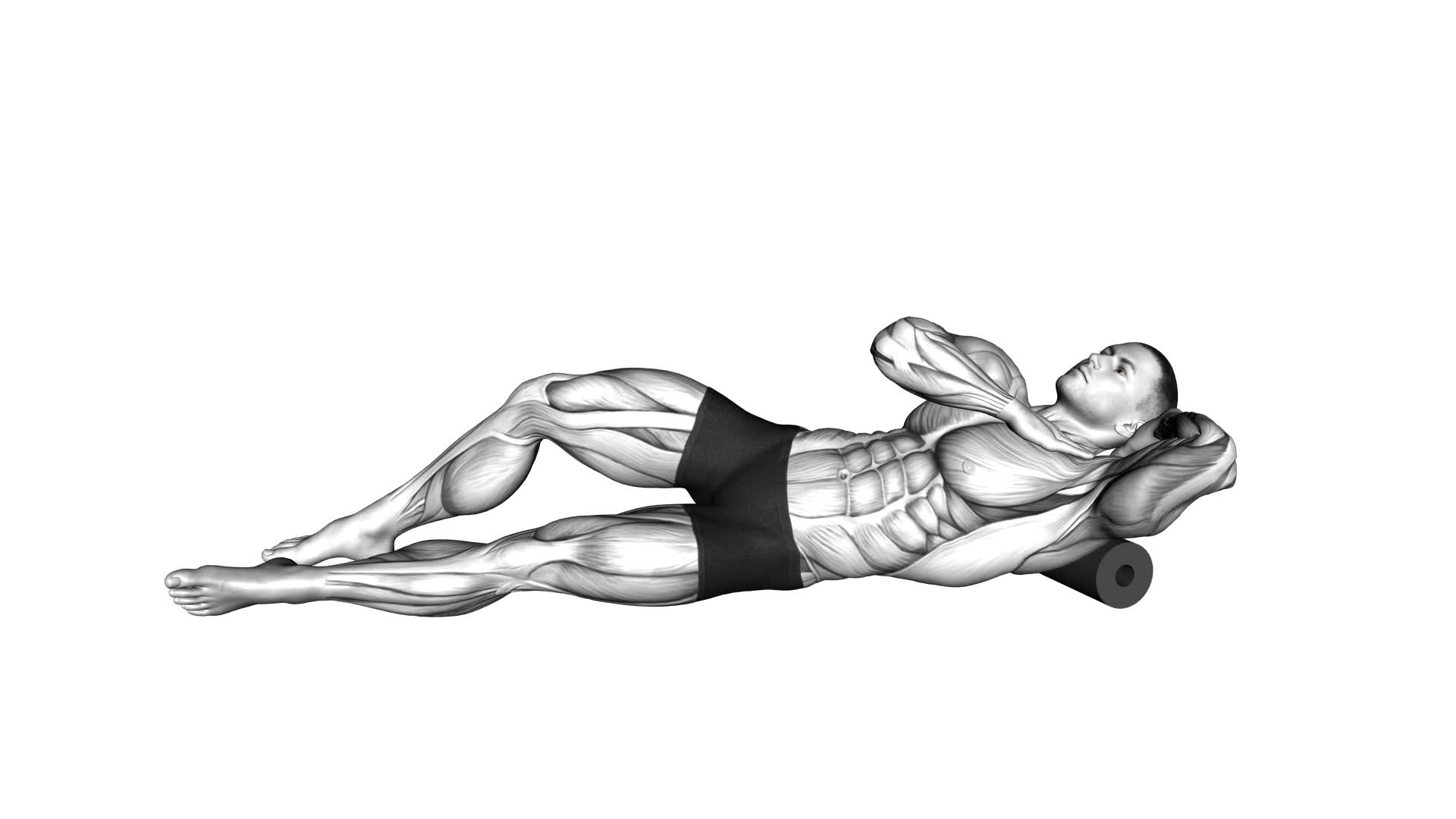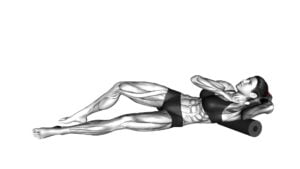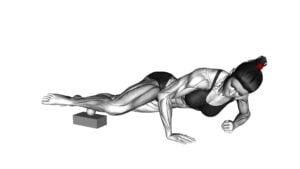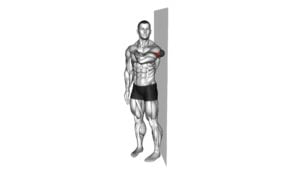Roll Posterior Shoulder Lying on Floor – Video Exercise Guide & Tips

Looking to strengthen your posterior shoulder muscles? Check out this video exercise guide and tips for the Roll Posterior Shoulder Lying on Floor.
Watch This Exercise Video
Learn the proper form and technique, as well as modifications and progressions for all fitness levels.
Avoid common mistakes and discover how to incorporate this exercise into your workout routine effectively.
Get ready to feel the burn and improve your shoulder strength with this targeted exercise.
Key Takeaways
- The roll posterior shoulder exercise improves shoulder mobility, strengthens the rotator cuff, and enhances overall shoulder flexibility and range of motion.
- It reduces the risk of shoulder injuries, alleviates shoulder pain and discomfort, and promotes relaxation while reducing muscle imbalances.
- Proper form and technique include lying on your back with knees bent, raising your arms towards the ceiling, holding them perpendicular to the floor, and avoiding arching the back while maintaining a neutral spine.
- Modifications and progressions for all fitness levels include using a foam roller or rolled-up towel for limited mobility, adding resistance with dumbbells or resistance bands, and consulting with a fitness professional for specific limitations or concerns.
Benefits of the Roll Posterior Shoulder Exercise
You will experience numerous benefits by incorporating the Roll Posterior Shoulder exercise into your workout routine. This exercise is highly effective in improving shoulder mobility and strengthening the rotator cuff. By performing this exercise regularly, you can enhance your overall shoulder flexibility and range of motion, making it easier to perform various upper body movements and exercises.
The Roll Posterior Shoulder exercise specifically targets the muscles in the back of your shoulder, also known as the posterior deltoids. These muscles play a crucial role in stabilizing and supporting the shoulder joint. By strengthening them, you can reduce the risk of shoulder injuries and improve your overall shoulder stability.
In addition to strengthening the rotator cuff, this exercise can also help alleviate shoulder pain and discomfort. By performing controlled, smooth rolling motions, you can release tension and tightness in the shoulder muscles, promoting relaxation and reducing muscle imbalances.
Incorporating the Roll Posterior Shoulder exercise into your workout routine can greatly enhance your shoulder mobility and overall shoulder health. It's important to note that proper form and technique are key to maximizing the benefits of this exercise. Let's delve into the next section to learn more about the correct form and technique for performing this exercise.
Proper Form and Technique for the Exercise
To perform the Roll Posterior Shoulder exercise with proper form and technique, follow these instructions:
- Lie on your back with your knees bent and feet flat on the floor. Keep your arms relaxed by your sides.
- Slowly raise your arms towards the ceiling while keeping them straight. As you lift, focus on squeezing your shoulder blades together.
- Continue to raise your arms until they're perpendicular to the floor. Hold this position for a brief pause before slowly lowering your arms back down to the starting position.
Proper form and technique are crucial when performing the Roll Posterior Shoulder exercise to ensure optimal results and prevent injury. Here are some common mistakes to avoid and workout routine tips to keep in mind:
- Avoid arching your back as you lift your arms. Keep your core engaged and maintain a neutral spine throughout the movement.
- Don't rush the exercise. Focus on controlled, deliberate movements to effectively target the posterior shoulder muscles.
- Breathe steadily throughout the exercise. Inhale as you lower your arms and exhale as you lift them.
Incorporating the Roll Posterior Shoulder exercise into your workout routine can help strengthen and tone the muscles in your upper back and shoulders. Remember to start with light weights or no weights at all, gradually increasing the resistance as your strength improves. Consult with a fitness professional if you have any concerns or specific limitations.
Modifications and Progressions for All Fitness Levels
Continuing from the previous subtopic, let's explore modifications and progressions for individuals of all fitness levels in the Roll Posterior Shoulder exercise.
Modifications can be made to accommodate those with limited mobility or strength, while progressions can challenge those who are more advanced.
For individuals with limited mobility, a modification of the Roll Posterior Shoulder exercise can be performed by using a foam roller or a rolled-up towel. Instead of lying on the floor, place the foam roller or towel under your shoulder blades and roll back and forth, targeting the posterior shoulder. This modification allows for increased support and can make the exercise more accessible for those with range of motion limitations.
On the other hand, for individuals looking to progress the exercise and make it more challenging, additional resistance can be added. This can be done by holding a dumbbell or a resistance band in your hand while performing the roll. The added resistance will engage the muscles of the posterior shoulder even more, helping to build strength and stability.
Common Mistakes to Avoid During the Exercise
One common mistake to avoid during the Roll Posterior Shoulder exercise is failing to maintain proper alignment. Proper form is crucial for maximizing the effectiveness of the exercise and minimizing the risk of injury. Here are some common mistakes to watch out for:
- Allowing the shoulders to hunch forward: When performing this exercise, it's important to keep your shoulders pulled back and down. Avoid rounding your upper back or allowing your shoulders to roll forward, as this can put unnecessary strain on the shoulders and neck.
- Using momentum instead of control: It's easy to get caught up in the movement and start using momentum to roll your shoulders. However, this takes away from the targeted muscles and reduces the effectiveness of the exercise. Instead, focus on using slow and controlled movements to engage the posterior shoulder muscles.
- Neglecting the core muscles: The Roll Posterior Shoulder exercise not only targets the posterior shoulder, but it also engages the core muscles for stability. Failing to engage your core can lead to poor form and decreased effectiveness. Remember to activate your core by pulling your belly button towards your spine throughout the exercise.
Tips for Incorporating the Roll Posterior Shoulder Exercise Into Your Workout Routine
To effectively incorporate the Roll Posterior Shoulder exercise into your workout routine, focus on maintaining proper form and engaging the targeted muscles. This exercise is great for strengthening and toning the posterior shoulder muscles, which can help improve your overall shoulder stability and prevent injuries.
Here are some tips to help you incorporate this exercise into your routine:
- Warm-up: Before starting any exercise, it's important to warm up your muscles to prevent injuries. Incorporate a few minutes of light cardio, such as jogging or jumping jacks, to get your blood flowing and muscles warmed up.
- Start with light weights: If you're new to this exercise or have weak shoulder muscles, start with light weights or no weights at all. Focus on perfecting your form and gradually increase the weight as you gain strength and confidence.
- Proper form: Lie on your back with your knees bent and feet flat on the floor. Hold a dumbbell in each hand, palms facing in. Slowly roll your shoulders back and down, squeezing your shoulder blades together. Pause for a moment at the top of the movement and then slowly lower the weights back to the starting position.
- Engage your core: To get the most out of this exercise, engage your core muscles throughout the movement. This will help stabilize your body and prevent any unnecessary strain on your lower back.
- Include it in your upper body routine: Incorporate the Roll Posterior Shoulder exercise into your upper body workout routine, along with other exercises that target the shoulders, such as shoulder presses and lateral raises. This will ensure that you're working all aspects of your shoulders and promoting balanced muscle development.
Frequently Asked Questions
How Many Sets and Repetitions Should I Do for the Roll Posterior Shoulder Exercise?
To determine the number of sets and repetitions for the roll posterior shoulder exercise, it's important to consider your fitness level and goals. Start with 2 to 3 sets of 10 to 12 repetitions and gradually increase as you get stronger.
Remember to listen to your body and adjust the intensity accordingly. Consulting with a fitness professional can also provide personalized guidance for optimal results.
Can I Do the Roll Posterior Shoulder Exercise if I Have a Shoulder Injury?
If you have a shoulder injury, it's important to modify exercises to avoid further damage.
When it comes to the roll posterior shoulder exercise, there are alternatives you can try that put less strain on your shoulder.
You could consider doing exercises that focus on strengthening the surrounding muscles or engaging in low-impact activities like swimming or yoga.
It's always best to consult with a healthcare professional or physical therapist to determine the safest options for your specific injury.
Is It Necessary to Use a Foam Roller for the Roll Posterior Shoulder Exercise?
Using a foam roller for the roll posterior shoulder exercise isn't necessary. There are alternative ways to perform this exercise without a foam roller. However, using a foam roller can have its benefits.
It can provide added support and stability while targeting the posterior shoulder muscles. Additionally, the foam roller can help to release tension and tightness in the muscles, enhancing the effectiveness of the exercise.
Can the Roll Posterior Shoulder Exercise Help Improve Posture?
Incorporating the roll posterior shoulder exercise into your workout routine can have several benefits, including improving your posture.
This exercise targets the muscles in your upper back and shoulders, helping to strengthen and stabilize them.
To execute the exercise properly for maximum effectiveness, lie on the floor with a foam roller positioned along your spine.
Roll the roller up and down, focusing on the posterior shoulder area.
Are There Any Variations of the Roll Posterior Shoulder Exercise for Targeting Specific Muscle Groups?
There are indeed variations of the roll posterior shoulder exercise that can help you target specific muscle groups. These variations allow you to focus on different areas, such as the upper back, shoulders, or even the core.
Conclusion
Incorporating the roll posterior shoulder exercise into your workout routine can provide numerous benefits for your shoulder muscles. By maintaining proper form and technique, you can effectively strengthen and stabilize your shoulders. Modifications and progressions are available for all fitness levels, ensuring that everyone can benefit from this exercise.
Be mindful of common mistakes to avoid during the exercise, and remember to consult with a professional trainer or therapist if needed. Start incorporating the roll posterior shoulder exercise into your routine for improved shoulder strength and mobility.

Author
Years ago, the spark of my life’s passion ignited in my mind the moment I stepped into the local gym for the first time. The inaugural bead of perspiration, the initial endeavor, the very first surge of endorphins, and a sense of pride that washed over me post-workout marked the beginning of my deep-seated interest in strength sports, fitness, and sports nutrition. This very curiosity blossomed rapidly into a profound fascination, propelling me to earn a Master’s degree in Physical Education from the Academy of Physical Education in Krakow, followed by a Sports Manager diploma from the Jagiellonian University. My journey of growth led me to gain more specialized qualifications, such as being a certified personal trainer with a focus on sports dietetics, a lifeguard, and an instructor for wellness and corrective gymnastics. Theoretical knowledge paired seamlessly with practical experience, reinforcing my belief that the transformation of individuals under my guidance was also a reflection of my personal growth. This belief holds true even today. Each day, I strive to push the boundaries and explore new realms. These realms gently elevate me to greater heights. The unique combination of passion for my field and the continuous quest for growth fuels my drive to break new ground.







